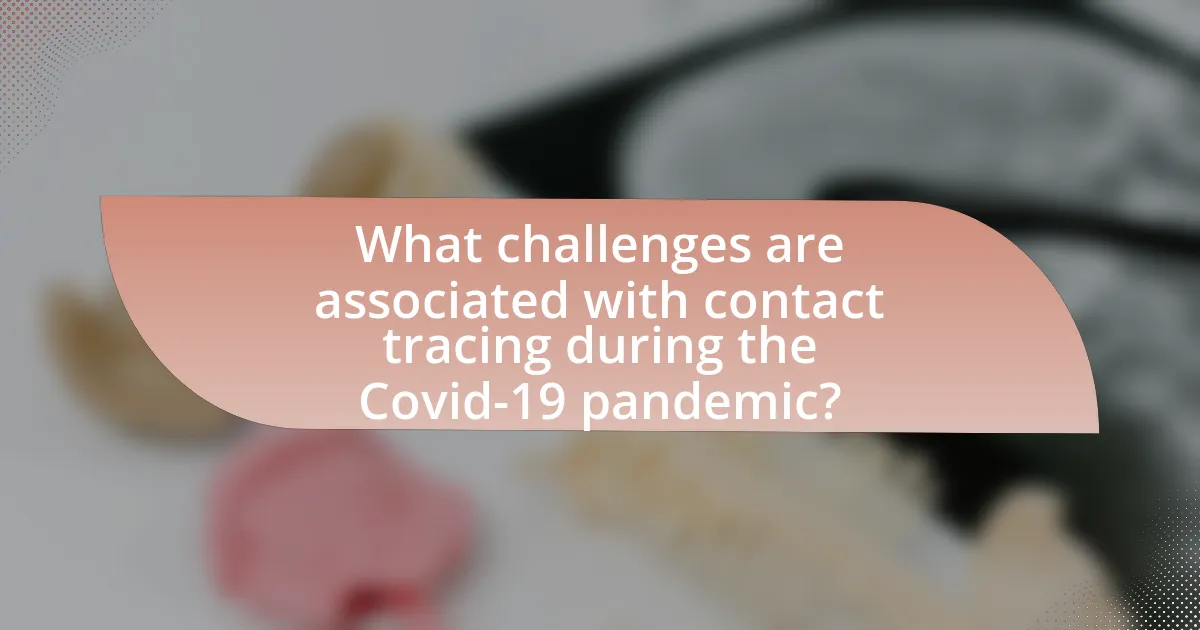Contact tracing is a vital component in the management of Covid-19, as it enables the identification and notification of individuals who have been in close contact with confirmed cases, thereby reducing virus transmission. The article outlines the process of contact tracing, including key steps such as identifying infected individuals, notifying contacts, and monitoring for symptoms. It also discusses the challenges faced during the pandemic, including privacy concerns and resource limitations, and highlights the importance of technology and public awareness in enhancing tracing efforts. Furthermore, the article examines the future implications of contact tracing for pandemic management and the role of personal responsibility in its success.

What is the Importance of Contact Tracing in Covid-19 Management?
Contact tracing is crucial in Covid-19 management as it helps identify and notify individuals who have been in close contact with confirmed cases, thereby reducing virus transmission. By promptly isolating these contacts, public health authorities can effectively contain outbreaks and prevent further spread of the virus. Studies have shown that effective contact tracing can reduce the reproduction number of the virus significantly; for instance, a report from the World Health Organization indicated that timely contact tracing can decrease transmission rates by up to 80%. This proactive approach not only protects public health but also aids in the efficient allocation of healthcare resources during a pandemic.
How does contact tracing function in the context of Covid-19?
Contact tracing functions in the context of Covid-19 by identifying and notifying individuals who have been in close contact with a confirmed case of the virus. This process involves health officials interviewing the infected person to determine their recent interactions and then reaching out to those contacts to inform them of potential exposure. According to the World Health Organization, effective contact tracing can reduce transmission rates by quickly isolating cases and advising contacts to quarantine, thereby preventing further spread of the virus.
What are the key steps involved in the contact tracing process?
The key steps involved in the contact tracing process include identifying infected individuals, notifying their contacts, and monitoring those contacts for symptoms. Initially, public health officials interview the infected person to gather information about their recent interactions. This information is then used to identify individuals who may have been exposed to the virus. Once contacts are identified, they are notified about their potential exposure and advised to quarantine or get tested. Monitoring involves regular check-ins to assess any symptoms that may develop. This systematic approach helps to contain the spread of COVID-19 by quickly isolating cases and preventing further transmission.
How is data collected and analyzed during contact tracing?
Data is collected during contact tracing through interviews with confirmed COVID-19 cases, where individuals provide information about their recent contacts, locations visited, and activities. This data is then analyzed using epidemiological methods to identify patterns of transmission and potential outbreaks. For instance, public health agencies utilize software tools to map contacts and assess risk levels, which helps in implementing timely interventions. The effectiveness of this approach is supported by studies showing that rapid identification of contacts can significantly reduce the spread of the virus, as evidenced by successful contact tracing programs in various countries during the pandemic.
Why is contact tracing critical for controlling the spread of Covid-19?
Contact tracing is critical for controlling the spread of Covid-19 because it identifies and informs individuals who have been in close contact with an infected person, allowing for timely isolation and testing. This process helps to break the chain of transmission, reducing the overall number of cases. Studies have shown that effective contact tracing can significantly lower infection rates; for instance, a model from the World Health Organization indicated that if 80% of contacts are traced and quarantined, the spread of the virus can be effectively controlled. By swiftly isolating those who may be infected, contact tracing not only protects public health but also alleviates pressure on healthcare systems.
What role does contact tracing play in identifying outbreaks?
Contact tracing plays a crucial role in identifying outbreaks by systematically tracking and notifying individuals who have been in close contact with an infected person. This process enables public health officials to quickly isolate cases, thereby preventing further transmission of the virus. For instance, during the COVID-19 pandemic, studies indicated that effective contact tracing could reduce the reproduction number of the virus significantly, as seen in countries like South Korea, where rapid identification and isolation of contacts helped control outbreaks.
How does contact tracing contribute to public health safety?
Contact tracing contributes to public health safety by identifying and notifying individuals who have been in close contact with someone infected with a contagious disease, such as COVID-19. This process helps to quickly isolate positive cases and prevent further transmission within the community. For instance, studies have shown that effective contact tracing can reduce the spread of COVID-19 by up to 80% when combined with other public health measures, such as testing and quarantine. By promptly informing contacts, public health officials can implement necessary interventions, thereby protecting vulnerable populations and reducing the overall burden on healthcare systems.

What challenges are associated with contact tracing during the Covid-19 pandemic?
Contact tracing during the Covid-19 pandemic faced significant challenges, primarily due to issues related to privacy concerns, public compliance, and resource limitations. Privacy concerns arose as individuals were hesitant to share personal information, fearing potential misuse of their data. Public compliance was another challenge, as many people were unwilling to participate in tracing efforts, leading to incomplete data and ineffective tracking of virus spread. Additionally, resource limitations, including insufficient personnel and technology, hindered the ability to conduct thorough and timely contact tracing, which is essential for controlling outbreaks. These factors collectively undermined the effectiveness of contact tracing as a public health strategy during the pandemic.
What are the common obstacles faced in effective contact tracing?
Common obstacles faced in effective contact tracing include inadequate resources, public reluctance to share information, and technological limitations. Inadequate resources, such as insufficient personnel and funding, hinder the ability to conduct thorough tracing. Public reluctance arises from privacy concerns and fear of stigma, leading to incomplete data collection. Technological limitations, including lack of access to reliable data systems and inconsistent use of contact tracing apps, further complicate the process. According to a study published in the journal “Nature,” these factors significantly reduce the effectiveness of contact tracing efforts in controlling the spread of infectious diseases like COVID-19.
How do privacy concerns impact the implementation of contact tracing?
Privacy concerns significantly hinder the implementation of contact tracing by creating distrust among the public regarding data collection and usage. When individuals fear that their personal information may be misused or inadequately protected, they are less likely to participate in contact tracing initiatives. For instance, a survey conducted by the Pew Research Center in 2020 revealed that 81% of Americans felt that the potential risks of data collection by the government outweighed the benefits. This apprehension can lead to lower participation rates, ultimately undermining the effectiveness of contact tracing efforts in controlling the spread of COVID-19.
What technological limitations hinder contact tracing efforts?
Technological limitations that hinder contact tracing efforts include inadequate data privacy measures, lack of interoperability between different tracing applications, and reliance on smartphone penetration rates. Inadequate data privacy measures can lead to public distrust, reducing participation in contact tracing initiatives. Lack of interoperability means that users of different systems cannot effectively share data, limiting the overall effectiveness of tracing efforts. Additionally, reliance on smartphone penetration rates restricts the reach of contact tracing, as populations without access to smartphones are excluded from these efforts. According to a study published in the journal “Nature,” effective contact tracing requires at least 60% of the population to participate, which is challenging when technological barriers exist.
How can these challenges be addressed to improve contact tracing?
To improve contact tracing, challenges can be addressed by implementing advanced technology solutions, enhancing public awareness, and ensuring data privacy. Advanced technology, such as mobile applications and digital tools, can streamline the process of identifying and notifying contacts quickly, as evidenced by the success of contact tracing apps in countries like South Korea, which reported a significant reduction in transmission rates. Enhancing public awareness through education campaigns can increase participation and compliance, as studies show that informed communities are more likely to engage in contact tracing efforts. Lastly, ensuring data privacy and security can build trust among the public, encouraging individuals to share their information without fear, which is crucial for effective contact tracing.
What best practices can enhance the effectiveness of contact tracing?
Effective contact tracing can be enhanced by implementing timely communication, utilizing technology, and ensuring comprehensive training for tracers. Timely communication allows for rapid identification and notification of potential exposures, which is crucial in controlling outbreaks. Utilizing technology, such as mobile applications for exposure notifications, can streamline the process and improve accuracy. Comprehensive training for contact tracers ensures they are equipped with the necessary skills to conduct interviews effectively and sensitively, which increases the likelihood of cooperation from individuals. Studies have shown that jurisdictions employing these best practices have reported higher success rates in identifying and managing contacts, thereby reducing transmission rates.
How can public awareness and education support contact tracing initiatives?
Public awareness and education significantly enhance contact tracing initiatives by fostering community cooperation and understanding of the process. When individuals are informed about the importance of contact tracing in controlling the spread of COVID-19, they are more likely to participate actively, report symptoms, and share their contacts. Research indicates that effective communication strategies can increase public compliance; for instance, a study published in the journal “Health Affairs” found that clear messaging about the benefits of contact tracing led to a 30% increase in participation rates. Furthermore, educational campaigns can dispel myths and reduce stigma associated with testing and tracing, thereby encouraging more people to engage with health authorities.

What are the future implications of contact tracing in pandemic management?
The future implications of contact tracing in pandemic management include enhanced public health response capabilities and improved disease surveillance systems. As demonstrated during the COVID-19 pandemic, effective contact tracing can significantly reduce transmission rates by quickly identifying and isolating infected individuals, thereby preventing outbreaks. Research indicates that countries employing robust contact tracing strategies, such as South Korea, experienced lower infection rates compared to those with less effective systems. Furthermore, advancements in technology, such as mobile applications for contact tracing, can streamline data collection and improve real-time response, making future pandemic management more efficient and effective.
How might contact tracing evolve post-Covid-19?
Contact tracing may evolve post-Covid-19 by integrating advanced technologies such as artificial intelligence and mobile applications to enhance efficiency and accuracy. These technologies can analyze large datasets to identify potential exposure risks more rapidly than traditional methods. For instance, countries like South Korea and Singapore have successfully implemented digital contact tracing systems that utilize GPS and Bluetooth technology, allowing for real-time notifications to individuals who may have been exposed to the virus. This evolution could lead to a more proactive approach in managing future outbreaks, as evidenced by the increased investment in public health infrastructure and digital health solutions during the pandemic.
What lessons can be learned from Covid-19 contact tracing for future pandemics?
Covid-19 contact tracing highlights the necessity of rapid response and efficient communication systems in managing pandemics. Effective contact tracing relies on timely identification of infected individuals and their contacts, which can significantly reduce transmission rates. For instance, studies show that countries with robust contact tracing protocols, such as South Korea, managed to control outbreaks more effectively, achieving lower infection rates compared to those without such measures. Additionally, the integration of technology, such as mobile applications for contact tracing, proved beneficial in enhancing the speed and accuracy of the process. These lessons underscore the importance of preparedness, resource allocation, and public cooperation in future pandemic responses.
How can technology shape the future of contact tracing?
Technology can significantly shape the future of contact tracing by enhancing data collection, improving accuracy, and facilitating real-time communication. Advanced technologies such as mobile applications, Bluetooth tracking, and artificial intelligence can streamline the process of identifying and notifying individuals who may have been exposed to infectious diseases. For instance, countries that implemented digital contact tracing apps, like Singapore’s TraceTogether, reported faster identification of contacts and reduced transmission rates. Furthermore, integrating location data and health records can provide public health officials with comprehensive insights, enabling more effective outbreak management and response strategies.
What practical steps can individuals take to support contact tracing efforts?
Individuals can support contact tracing efforts by promptly reporting any COVID-19 symptoms and testing results to health authorities. This action enables health officials to identify and notify individuals who may have been exposed to the virus, thereby preventing further transmission. Additionally, individuals should maintain accurate records of their close contacts and locations visited, as this information is crucial for effective tracing. Studies have shown that timely reporting and accurate contact information significantly enhance the efficiency of contact tracing programs, leading to quicker isolation of cases and reduced spread of the virus.
How can individuals effectively report their contacts during an outbreak?
Individuals can effectively report their contacts during an outbreak by utilizing digital contact tracing applications, maintaining a personal log of interactions, and promptly notifying health authorities. Digital applications, such as those developed by public health agencies, automatically track and notify users of potential exposure, enhancing accuracy and speed in reporting. Keeping a personal log of interactions, including dates, times, and locations, allows individuals to provide detailed information to health officials, which is crucial for effective contact tracing. Promptly notifying health authorities ensures that necessary measures can be taken to contain the outbreak, as timely reporting has been shown to significantly reduce transmission rates, as evidenced by studies conducted during the COVID-19 pandemic.
What role does personal responsibility play in the success of contact tracing?
Personal responsibility is crucial for the success of contact tracing as it ensures individuals accurately report their symptoms and potential exposures. When people take responsibility for their health and communicate transparently with health authorities, it enhances the effectiveness of tracing efforts. For instance, studies have shown that timely reporting of symptoms and contacts can significantly reduce the spread of infectious diseases, as seen during the COVID-19 pandemic where countries with higher compliance rates in self-reporting saw lower transmission rates. Therefore, personal accountability directly influences the efficiency and reliability of contact tracing initiatives.


